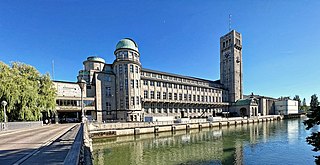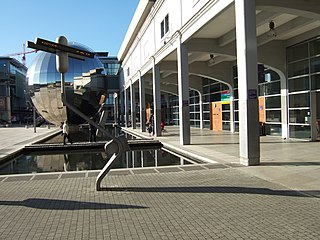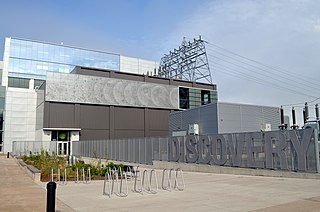
The Griffin Museum of Science and Industry(MSI), formerly known as the Museum of Science and Industry, is a science museum located in Chicago, Illinois, in Jackson Park, in the Hyde Park neighborhood between Lake Michigan and The University of Chicago. It is housed in the Palace of Fine Arts from the 1893 World's Columbian Exposition. Initially endowed by Sears, Roebuck and Company president and philanthropist Julius Rosenwald and supported by the Commercial Club of Chicago, it opened in 1933 during the Century of Progress Exposition. It was renamed for benefactor and financier Kenneth C. Griffin on May 19, 2024.

A science museum is a museum devoted primarily to science. Older science museums tended to concentrate on static displays of objects related to natural history, paleontology, geology, industry and industrial machinery, etc. Modern trends in museology have broadened the range of subject matter and introduced many interactive exhibits. Modern science museums, increasingly referred to as 'science centres' or 'discovery centres', also feature technology.

The Science Museum is a major museum on Exhibition Road in South Kensington, London. It was founded in 1857 and is one of the city's major tourist attractions, attracting 3.3 million visitors annually in 2019.

The National Motor Museum is a museum in the village of Beaulieu, set in the heart of the New Forest, in the English county of Hampshire.

The National Science and Media Museum, located in Bradford, West Yorkshire, is part of the national Science Museum Group in the UK. The museum has seven floors of galleries with permanent exhibitions focusing on photography, television, animation, videogaming, the Internet and the scientific principles behind light and colour. It also hosts temporary exhibitions and maintains a collection of 3.5 million pieces in its research facility.

The Deutsches Museum in Munich, Germany, is the world's largest museum of science and technology, with about 125,000 exhibited objects from 50 fields of science and technology. It receives about 1.5 million visitors per year.

Liberty Science Center is an interactive science museum and learning center located in Liberty State Park in Jersey City, New Jersey, United States. At its opening, it was the largest such planetarium in the Western Hemisphere and the world's fourth largest.

We The Curious is a science and arts centre and educational charity in Bristol, England. It features over 250 interactive exhibits over two floors, and members of the public and school groups can also engage with the Live Science Team over programming in the kitchen, studio and on live lab. We The Curious is also home of the United Kingdom's first 3D planetarium. The centre describes its aim as being "to create a culture of curiosity".

Richard Langton Gregory, was a British psychologist and Professor of Neuropsychology at the University of Bristol.

The Royal Photographic Society of Great Britain, commonly known as the Royal Photographic Society (RPS), is one of the world's oldest photographic societies. It was founded in London, England, in 1853 as the Photographic Society of London with the objective of promoting the art and science of photography, and in 1853 received royal patronage from Queen Victoria and Prince Albert.

Guinness Storehouse is a tourist attraction at St. James's Gate Brewery in Dublin, Ireland. Since opening in 2000, it has received over twenty million visitors.

The Victoria Rooms, also known as the Vic Rooms, houses the University of Bristol's music department in Clifton, Bristol, England, on a prominent site at the junction of Queens Road and Whiteladies Road. The building, originally assembly rooms, was designed by Charles Dyer and was constructed between 1838 and 1842 in Greek revival style, and named in honour of Queen Victoria, who had acceded to the throne in the previous year. An eight column Corinthian portico surmounts the entrance, with a classical relief sculpture designed by Musgrave Watson above. The construction is of dressed stonework, with a slate roof. A bronze statue of Edward VII, was erected in 1912 at the front of the Victoria Rooms, together with a curved pool and several fountains with sculptures in the Art Nouveau style.
Bristol is the largest city in South West England, and as such is a centre for culture, research and higher education in the region. The city is home to a prestigious "red brick university" and a high-ranking "new university". The city is also noted for its investment in the sciences and engineering, particularly its ties to the aerospace industry.

Techniquest is a science discovery centre located in Cardiff Bay, Wales. It gives visitors a hands-on approach to science and includes a science theatre, a planetarium, and an exhibition space with over 100 interactive exhibits aimed at visitors of all ages.

The Catalyst Science Discovery Centre and Museum is a science and technology museum in Widnes, Halton, North-West England. The centre has interactive exhibits, reconstructed historical scenes, an observatory, a live-science theatre and family workshops. It is next to Spike Island, a public park, located between the River Mersey and the Sankey Canal that has woodlands, wetlands, footpaths and industrial archaeological history.

Since the first broadcast of the British science-fiction television serial Doctor Who in 1963, there have been a number of exhibitions of props, costumes and sets relating to the show throughout the United Kingdom. Some have been intended to be permanent, and others seasonal; most have been staged at existing tourist locations. None are currently open to the public.

Discovery Centre is an interactive science museum in Halifax, Nova Scotia. It is a not-for-profit charitable organization whose mission is to stimulate interest, enjoyment and understanding of science and technology.
Physics outreach encompasses facets of science outreach and physics education, and a variety of activities by schools, research institutes, universities, clubs and institutions such as science museums aimed at broadening the audience for and awareness and understanding of physics. While the general public may sometimes be the focus of such activities, physics outreach often centers on developing and providing resources and making presentations to students, educators in other disciplines, and in some cases researchers within different areas of physics.
Science tourism is a travel topic grouping scientific attractions. It covers interests in visiting and exploring scientific landmarks, including museums, laboratories, observatories and universities. It also includes visits to see events of scientific interest, such as solar eclipses.

The MagnifiScience Centre (MSC) is an independent science center in Karachi, with a mission to develop among the populace an interest in scientific thinking, scientific literacy, and scientific methods through engagement with interactive exhibits and programmes.



















